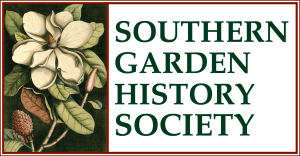
Credit: Carol M. Highsmith, Carol M. Highsmith Archive, Library of Congress, Prints and Photographs Division.
In our February 21, 2025, Tryon Palace “Gardens” post readers were promised a look at the historic landscape of Edenton, which was visited and much appreciated by SGHS members during the 2001 New Bern-based annual meeting. Again, planning credit goes to Perry Mathewes and Carleton Wood, including kudos for their role in coordinating a day’s activities in Edenton. Sadly, however, in 2019 we lost long-time Society member Frances Drane Inglis, whose role was central in making our Edenton time memorable.
Prior to arrival in the town, the group visited Somerset Place, south of the Albemarle Sound. They explored a state historic site located on 16,600-acre Lake Phelps and situated amid the vast fields that typify this region. The site, they learned, had over the previous decade greatly widened its interpretive mission from a focus chiefly on the one-time plantation owners, the Collins family, to a conversation that gives due attention to the many enslaved families who both worked in and around the big house and who also labored across hundreds of Somerset acres. To that end, several of their nearby dwelling places and an overseer’s house had been recreated to represent better the pre-Civil War cultural landscape. A look at ornamental plants here largely involved a discussion of the interests of Mary Riggs Collins and her formal gardens near the Collins’ home, a cultivated area that once encompassed four acres.*
Located on the north side of the Albemarle Sound, the one-time colonial capital and port of Edenton shares the distinction with New Bern and other early North Carolina towns of having been mapped by Claude Joseph Sauthier.** Our visit here began at Hayes Farm on Edenton’s edge, a site drawn by Sauthier. Named for Walter Raleigh’s birthplace, Hayes is famed for a designed landscape dating to the early nineteenth century.
The town, of course, has expanded since Sauthier executed his plan in 1769. Yet, features of the British colonial landscape remained to explore in 2001. Sited five blocks from the waterfront, Edenton’s Church of England sanctuary (now St. Paul’s Episcopal Church) had the distinction of being marked “A,” reflecting its status both as a house of worship and an arm of royal power in the colony. While early-eighteenth-century graveyard markers do not survive, stones populate the churchyard evoking thoughts of later late-eighteenth-century through modern times Edenton residents.
Nearer the water, Sauthier map feature “B” indicated the county courthouse, a finely-crafted Flemish-bond brick structure dating to 1767 and considered among the best of its type in the South. Since SGHS members have an eye for landscape design, the juncture of courthouse on the north, courthouse green, and waterfront setting on the south made this spot a highlight of the Edenton visit. In addition, that evaluation was underscored by time spent at the Homestead, the private eighteenth-century home and gardens of Frances and Ross Inglis located at the southwest corner of the courthouse green. Members were particularly impressed here, and elsewhere in Edenton, and at Hayes Farm, by the array of antique roses present, some having been in place since the nineteenth century. Those Peggy Cornett recalled in her Summer 2001 Magnolia meeting review included “‘Old Blush’ China, Chestnut Rose, ‘Souvenir de la Malmaison’, ‘Duchesse de Brabant’, ‘Safrano’, and ‘Isabella Sprunt’.”
A block west of the Homestead, the Cupola House has a prime spot on any list of important Edenton garden locations. Dating to 1758 and open to the public, the structure appears on Sauthier’s map, with a parterre garden set between house and the waterfront. It is hard to overstress its historic and architectural importance, along with the part this once-threatened dwelling played in awakening a spirit of preservation in Edenton. Built under the direction of Lord Granville’s land distribution agent Francis Corbin, it initially housed an office and records room, along with a meeting/dining room and bed chambers, while its famous cupola offered views over Edenton Bay. (The Earl of Granville then owned approximately one-half of modern North Carolina, inherited from his Lord Proprietor grandfather.)
Readers may recall an announcement of a Cupola House historic plant database in the Fall 2006 Magnolia. Created by Frances Inglis and Mary Kay Coyle, this extensive body of information is available on the property’s website.*** It offers an excellent review in text and images of what visitors might find growing there over the seasons, some of which were experienced by Society member during their 2001 garden walkabout.
*************************************************************
*For a deeper look at Somerset Place and the activities of Mary Riggs Collins, search in the Magnolia Index https://www.southerngardenhistory.org/wp-content/250623_index.htm under both “Somerset Place plantation” and “John C. Sykes, III, Mary Riggs Collins and the Somerset Place Gardens.”
**For a handy online Sauthier Edenton map, see: https://digital.lib.ecu.edu/30488
*** https://cupolahouse.org/plant-library/
A memorable look at Frances Inglis and a visit with her to the Cupola House can be viewed at: https://www.youtube.com/watch?v=bzTunlpu5tc

Leave a Reply